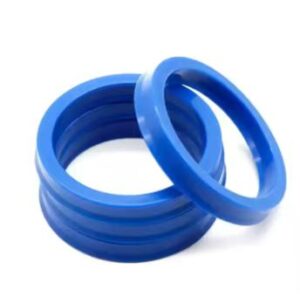Table of Contents
ToggleWhat is a Rod Seal?
A rod seal (also referred to as a gland seal, headbush, or neck seal) is a vital sealing component in hydraulic and pneumatic systems. Its primary purpose is to prevent fluid or gas leakage along reciprocating rods, such as piston rods in cylinders, while maintaining system integrity. This article explores the design, function, types, applications, and maintenance practices of rod seals, providing a comprehensive understanding of their role in industrial and mechanical systems.


Overview of Rod Seals
Rod seals are dynamic sealing elements installed on the piston rod of hydraulic or pneumatic cylinders. Positioned within the cylinder’s gland (the end cap where the rod exits), they form a pressure barrier to retain operating fluid or gas inside the system and block external contaminants like dust, dirt, and moisture. These seals work alongside other components, such as wiper seals and buffer seals, to ensure optimal performance and longevity of the system [1][2].
Key Terminology
- Gland: The housing where the rod seal is mounted.
- Reciprocating Motion: The back-and-forth movement of the rod.
- Dynamic Sealing: Sealing under moving conditions, as opposed to static seals.
Core Functions of Rod Seals
1. Fluid/Gas Retention
Rod seals prevent leakage of hydraulic fluid or compressed air during the rod’s reciprocating motion, ensuring efficient power transmission and pressure maintenance.
2. Contamination Prevention
By sealing the gap between the rod and gland, rod seals protect internal components from abrasive particles, moisture, and environmental debris.
3. Pressure Regulation
In high-pressure systems, rod seals maintain consistent internal pressure, preventing energy loss and system inefficiency.
4. Lubrication Retention
They help retain a thin oil film on the rod surface, reducing friction and wear during operation.
Design and Material Selection
Material Considerations
Rod seals are manufactured from wear-resistant materials tailored to specific operational demands:
- Polyurethane (PU): Offers excellent abrasion resistance and durability for medium-to-high-pressure applications.
- Nitrile Rubber (NBR): Ideal for low-pressure systems requiring elasticity and cost-effectiveness.
- Fluorocarbon (FKM): Resistant to high temperatures and aggressive chemicals.
- Polytetrafluoroethylene (PTFE): Used in composite seals for low friction and high-temperature/corrosive environments [3][4].
Common Seal Types
- Lip Seals:
- Designed for dynamic sealing under pressure.
- Feature a flexible lip that conforms to the rod surface.
- U-Cup Seals:
- Bidirectional sealing capability.
- Suitable for high-pressure hydraulic systems.
- Composite Seals:
- Combine elastomers (e.g., O-rings) with PTFE or thermoplastic shells.
- Deliver low friction and extended service life.
- Vee-Packing (Chevron Seals):
- Stackable multi-lipped seals for heavy-duty applications.
- Often used in industrial presses and construction machinery.
- Grooved Rod Seals:
- Single-acting seals with anti-extrusion rings to prevent deformation under pressure [1][5].
Critical Operational Considerations
Pressure and Temperature
Rod seals must withstand system-specific pressures (up to 6,000 psi in hydraulics) and temperatures (ranging from -40°C to 200°C). Material selection directly impacts performance under these conditions.
Surface Finish Requirements
The piston rod’s surface must have a smooth finish (typically 0.2–0.4 μm Ra) to minimize seal wear while retaining lubrication. Rough surfaces accelerate seal degradation.
Installation Precision
Proper installation ensures:
- Correct alignment to prevent twisting or extrusion.
- Adequate lubrication to avoid dry starts.
- Compatibility with groove dimensions for optimal compression.
Applications Across Industries
Rod seals are integral to systems requiring precise fluid or gas control:
- Hydraulic Cylinders: Excavators, cranes, agricultural machinery.
- Pneumatic Cylinders: Robotics, automation systems, assembly lines.
- Automotive Systems: Shock absorbers, suspension components.
- Industrial Machinery: Presses, injection molding equipment.
Failure Modes and Mitigation
Common Causes of Failure
- Wear: Gradual material degradation due to friction or abrasive contaminants.
- Extrusion: Seal deformation under excessive pressure.
- Chemical Degradation: Incompatibility with operating fluids or extreme temperatures.
- Installation Errors: Misalignment, improper lubrication, or groove damage.
Preventive Maintenance Strategies
- Regular Inspections: Check for leaks, surface scratches on the rod, and seal wear.
- Seal-Wiper Pairing: Use compatible wiper seals to avoid stripping the rod’s lubricating film.
- Timely Replacement: Overhaul seals during scheduled maintenance to prevent unexpected downtime [6].
Differentiation from Piston Seals
While rod seals focus on sealing the rod-gland interface, piston seals are located on the piston itself, separating pressure zones within the cylinder bore. Piston seals prevent fluid bypass between the piston and cylinder wall, whereas rod seals address leakage at the dynamic exit point.
Advanced Sealing Systems
Modern systems often employ multi-seal arrangements to enhance performance:
- Buffer Seals: Absorb pressure spikes to protect primary rod seals.
- Wiper Seals: Remove contaminants from the rod before it retracts into the cylinder.
- Scraper Seals: Used in extremely dirty environments to prevent particulate ingress.
Best Practices for Longevity
- Material Compatibility: Match seal materials to fluid type, temperature, and pressure.
- Surface Hardening: Use chrome-plated or nitrided rods to reduce wear.
- Lubrication Management: Ensure adequate oil film thickness on the rod surface.
- Training: Educate technicians on proper handling and installation techniques.
Conclusion
Rod seals are indispensable for maintaining the efficiency, reliability, and safety of hydraulic and pneumatic systems. Their design—whether lip seals, U-cups, or composite configurations—is tailored to meet the demands of diverse applications, from construction equipment to precision automation. By adhering to best practices in material selection, installation, and maintenance, engineers can significantly extend the operational life of these critical components.



Leave A Comment